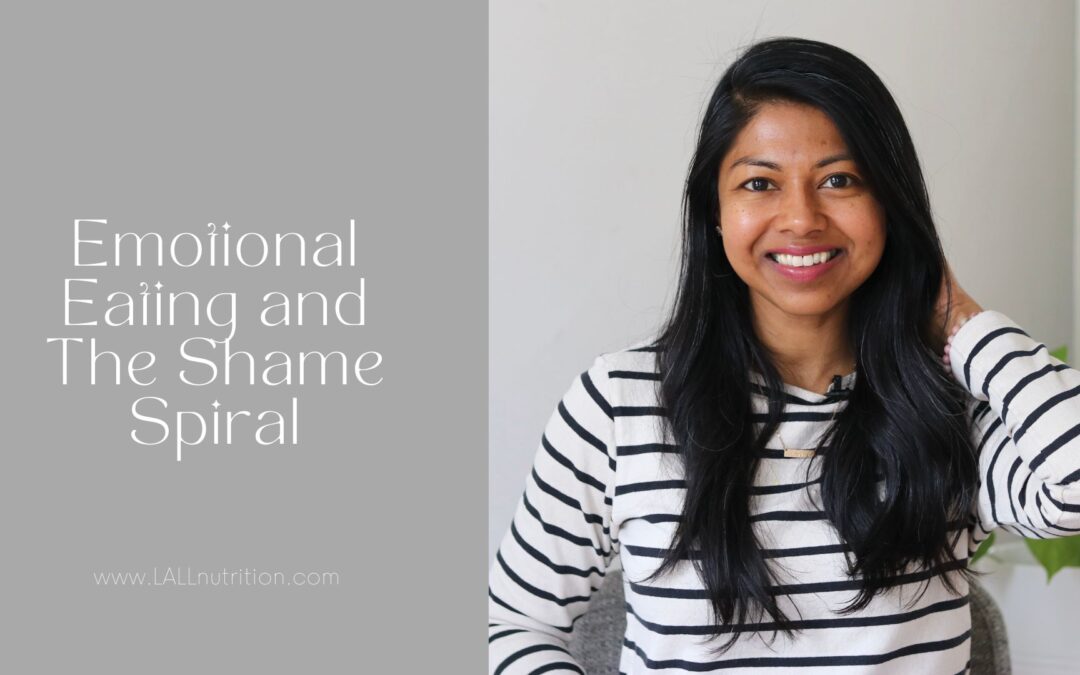Hello love,
I wanted to share with you a little bit more about emotional eating and the shame spiral. It’s important that we talk about how we feel when we’re in this pattern.
What I hear from women is that they feel shame that they’re emotionally eating. They feel so much shame around their behaviour. They’re hiding and eating after everyone goes to bed when they’re alone in their car, etc.
Emotional eating is a compulsive behaviour. There’s a lot of internal shame around not being able to control it and feeling out of control. The shame of our behaviour is on the surface, because emotional eating is a multilayered pattern.
What happens when we emotionally eat? We feel shame. Then that shame triggers more emotional eating, and we’re in the cycle. Round and round it goes.
Emotional eating is a coping mechanism. It’s when we use food to soothe ourselves from any discomfort, any uncomfortable emotions, any sort of stress. Shame triggers emotional eating. This pattern usually develops in childhood when our parents or caregivers didn’t model or help us move through our uncomfortable emotions or stressors.
We weren’t regulated, we weren’t seen, heard, validated or accepted in our emotions. We felt a lot of rejection around them. We felt something was wrong with us. Maybe we felt we were too sensitive.
As children, we don’t want to make our parents upset, dislike us or not love us. So we keep those emotions in. That discomfort stays with us, and we do whatever we can to just appear the way we’re “supposed” to.
The 2 layers of shame
We start contorting ourselves. But that uncomfortable emotion, that discomfort, that stress, it lives in us.
We have to figure out ways to manage it. Cue coping with food.
But coping is managing our stress and is not a true resolution.
Now as an adult, when we emotionally eat, we feel shame for the emotional eating behaviour. This behaviour we use to cover up the shame that is triggered.
So you see how this can become multilayered.
Trying to avoid shame but creating more
So most of the times when we’re going towards diets, they’re not connected to who we are. They’re a mechanism to control our body and restrict calories. For instance we want to get to a certain size and we push our bodies past it’s limit. We’re not honouring our bodies and pushing it to try to look a certain way. When we fail, we are critical which triggers shame and our emotional eating.
When we can’t willpower our way into the diet or the body, we feel something’s even wrong with us. So we failed again at another diet, we failed again at another exercise program or trying to be healthy. We don’t realize those conventional things are not set up to help the body. Plus with this emotional eating pattern you’ll get derailed when that shame comes up.
These are the layers of shame – you have these unhealthy ways of being with food, being with your body, and now with your emotions.
The shame keeps building up because it seems like everything you do, you’re still spiralling into your emotional eating.
So how do we resolve this pattern?
So this was the same thing for me. I had this coping mechanism that I wasn’t aware of. I had the typical restriction relationship to food & my body. I thought I needed to control my body.
The first step for me was to understand I had this emotional eating pattern that created shame. It’s the same for my clients.
We need to start shifting this because a lot of clients that come to me, they are hiding and emotionally eating, they’re doing it when they’re alone. No one knows they’re suffering, they’re feeling this way internally and so there’s nothing that can be done.
When you think something’s wrong with you and you’re broken and you need to be fixed, you go and find solutions that tell you you’re broken and need to be fixed.
What we need:
1. To understand this pattern.
2. Get into those deeper roots and shift our relationship to food, our body and our emotions.
Inside of The Emotional Eating Evolution Program we’re creating a new way of being with food, our body and our emotions. One that is in alignment for us and healthy.
We’re no longer using food to soothe. This will help our nervous system and our body start regulating, coming back to a state of calm vs. stress/control. This is where our stress is reduced. We start having better digestion. We feel more at ease in our body. We’re going to release whatever weight has been put on us. This is why I say weight is just a symptom of our emotional eating. We need to be shifting our pattern around these areas.
This is where we feel more empowered, we have more boundaries, we understand ourselves more and this is how we start moving away from shame.
My journey and following this method
What I saw when I was on this journey was my body started to shift when I was honoring the food choices I was making.
I was accepting my body and moving through those uncomfortable emotions that would pop up and make me emotionally eat.
I was creating this new structure for myself around what a healthy relationship looks like in terms of nourishment, in terms of body movement, in terms of emotional wellness.
These pieces working together that’s what resolves your emotional eating long term and what disintegrates and integrates that shame.
You have deep compassion for yourself and you’re making the changes that you need to make in a sustainable way to get that result.
Invitation
If you are interested in shifting your emotional eating to resolving it so you can finally feel confident in your body and around food, I’d love to invite you to find out more about The Emotional Eating Evolution Program here. This is a step by step methodology with lots of support, guidance, coaching, meditations to get to the root, to resolve your emotional eating so you can finally feel confident in your body and around food.
If the program resonates the next step would be to book in an Emotional Eating Clarity call. On the call we find out more about you, your struggles and how we can support you in the program to meet your goals.
To integration,
Michelle
Certified Holistic Nutritionist Specializing in Emotional Eating


